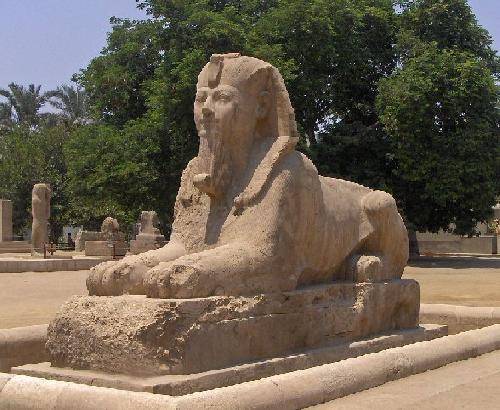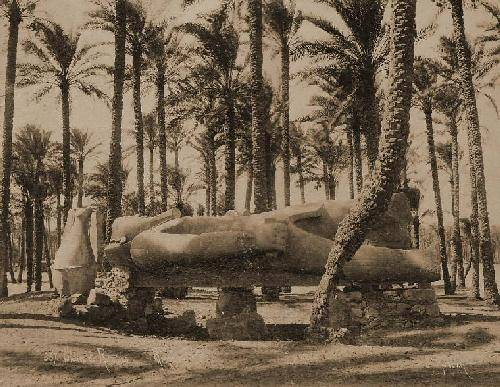

Memphis is the first capital of the unified Egypt. It was Narmer, the founder of the One Dynasty, who initiated its establishment. It was known by three names: ’Inb-hd (the White Wall), Mn-nfr (Stable and Beautiful), and Mt-Rhn (the Rams' way). It remained the capital of Egypt from the First Dynasty throughout the Eighth Dynasty. The creation mythology of the Triad of Ptah, Sekhmet and Nefertem (known as the Triad of Memphis) took Memphis as its center. Within the limits of Memphis, stretches the Necropolis of Memphis, the biggest and most famous necropolis in Egypt that includes monuments of all kings of Egypt. In his lifetime, Alexander the Great visited the site; and after his death, he had his mummy lying here for almost a year till the completion of his tomb in Alexandria.
 Most of the Ptolemies had the name of its god, Ptah, as part of their names. The Greeks called it 'Memphis' and one of the modem cities in the world nowadays has this name as well. The priests assembled in Memphis in 196 BC to record thanks to King Ptolemy V who gave them his blessings and gifts and was generous to their temples. This event was recorded in Hieroglyphic, Demotic, and Greek on the 'Rosetta Stone', that was discovered by the French campaign in 1799 in Rosetta. The small village of Mit-Rahina (Memphis) was much affected by many agricultural and building projects by the modern man. Still, it has some remains of old constructions scattered around it. Memphis had always been the most coveted place in the region if not of Egypt that many invaders desired to seize it: Both Piankhy (Piye), one of the Kushite kings of Nubia, and the Assyrians had aspiring ambitions to overtake the site. And later, Cambyses totally destroyed the city and killed the priests of Ptah and the Apis-bull. And it was not long before a decree of the Roman Emperor Theodosius ordered the temples be damaged and the gods' statues be destroyed leaving it totally in ruins. Additionally, the site was used as a quarry. One its land, Memphis comprises a huge number of temples that were dedicated to god Ptah and the Triad, especially that one famously known as 'Hutkaptah', from which the name Egyptos is driven.
Most of the Ptolemies had the name of its god, Ptah, as part of their names. The Greeks called it 'Memphis' and one of the modem cities in the world nowadays has this name as well. The priests assembled in Memphis in 196 BC to record thanks to King Ptolemy V who gave them his blessings and gifts and was generous to their temples. This event was recorded in Hieroglyphic, Demotic, and Greek on the 'Rosetta Stone', that was discovered by the French campaign in 1799 in Rosetta. The small village of Mit-Rahina (Memphis) was much affected by many agricultural and building projects by the modern man. Still, it has some remains of old constructions scattered around it. Memphis had always been the most coveted place in the region if not of Egypt that many invaders desired to seize it: Both Piankhy (Piye), one of the Kushite kings of Nubia, and the Assyrians had aspiring ambitions to overtake the site. And later, Cambyses totally destroyed the city and killed the priests of Ptah and the Apis-bull. And it was not long before a decree of the Roman Emperor Theodosius ordered the temples be damaged and the gods' statues be destroyed leaving it totally in ruins. Additionally, the site was used as a quarry. One its land, Memphis comprises a huge number of temples that were dedicated to god Ptah and the Triad, especially that one famously known as 'Hutkaptah', from which the name Egyptos is driven.


Only the remains of the Temple of Ptah are still there; it once had inside it the statue now erected in' Ramses Square. This temple was built during the reign of Ramses II, and it was added to by King Merenptah and others. There was another temple that was set up during the reign of these two kings, and it includes a chapel that was constructed during the reign of King Seti I. The city includes a number of palaces, one of which belongs to King Merenptah, and the other to King Wahibre (Apries), of the Twenty-sixth Dynasty. At the site, there is an open museum is which the colossal statue of pink granite, which lies down, and a number of standing statues bearing the name of Ramses II were found. However, recent studies show that they belong to King Senusert I, of the Twelfth Dynasty. The site includes also the second biggest Sphinx, after that of the Giza plateau, made of alabaster and dates back to the New Kingdom. Also found at the spot was a stela of King Apries. Among the monuments discovered here is a mummification temple that was reserved to the mummification of the Apis-bull, before its burial in the Serapeum of Saqqara. Dating back to the Twenty-sixth Dynasty, this temple still includes some offering tables as well as canopic jars. To the south of the mummification temple, were discovered a tomb for Shashonk of the Twenty-second Dynasty and a necropolis of the Middle Kingdom. Among the remains of the site are the remains of a temple built in the Ninth Dynasty.
